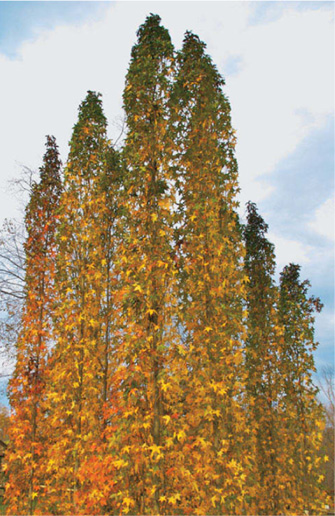
Short or tall flower spikes in summer: A Lysimachia atropurpurea; B Veronica spicata; C Kniphofia hybrid; D Rudbeckia maxima; E Thalictrum rochebrunianum; F Heuchera villosa; G Liatris spicata; H Salvia superba; I Veronicastrum virginicum; J Veronica spicata ‘Foxy’; K Cimicifuga (syn. Actea) racemosa; L Heucherella hybrid.


Flowers come in many forms, shapes, and sizes. It’s up to us to decide how to use them. We may contrast one large flower with many small ones. We may create dynamic rhythm within a planting— using the repetition of elements or waves of undulating forms. We can also announce the high notes and even elevate a scene with the shapes of inflorescences— groupings of multiple flowers on a single stem.
There are herbaceous plants like certain Veronica species that produce what appear to be clusters of stalagmites, or inverted icicles. These ascending spires are like exclamation points providing excitement and movement—shifting the viewer’s eyes skyward. Delphiniums have a commanding presence with blue or white blossom-laden stems, as does the tender mealycup sage, Salvia farinacea, on a much smaller scale. More upstanding perennials include the obedient plant (Physostegia virginiana), blazing star (Liatris spp.), red hot poker (Kniphofia spp.), Culver’s root (Veronicastrum virginicum), black cohosh (Actaea spp., formerly Cimicifuga), and Astilbe and Penstemon species and varieties.
Contrast these vertical flowers with plants that have broad, rounded leaves. A few Ligularia species are perfect— providing the textural contrast on their own. Some species (L. dentata ‘Othello’, for instance) have dark water-lily-pad-like leaves and tall stems bearing garish Kodak-yellow daisy flowers. Others species and varieties (L. stenocephala ‘The Rocket’, for example) have toothed triangular leaves with starry lemon yellow flowers covering tall conical spires.
Other vertical herbaceous perennials punctuate a planting with their stature and hold their blossoms at the top rather than have them running up the stems. Rudbeckia maxima, for example, sends up towering shafts with yellow coneflowers above silvery blue-green leaves. On the other hand, subtle grace comes from lavender mist meadow rue (Thalictrum rochebrunianum), providing a more delicate touch for a bed or border. Here, purple, white, and yellow flowers float on wiry stems some seven to eight feet in the air.
There are shrubs and trees that grow into natural pillars described as columnar. Those that are similar but not quite as narrow are described as fastigiate. These plants grow with parallel, vertical branches. Examples include boxwood (Buxus) ‘Graham Blandy’ and ‘Fastigiata’, columnar Irish yew (Taxus baccata ‘Fastigiata’), and a sweetgum tree selection— Liquidambar styraciflua ‘Slender Silhouette’. This telephone-pole-thin genetic variation was found growing beside a lake in Tennessee by nurseryman Don Shadow. Cuttings were taken and propagated. These sentinels make an unforgettable statement.
A grove of columnar Liquidambar styraciflua ‘Slender Silhouette’.
